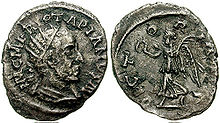
Gaius Julius Antiochus IV Epiphanes, the last king of Commagene, reigned between 38–72 as a client king to the Roman Empire. The epithet "Epiphanes" means "the Glorious".

Philip the Arab was Roman emperor from 244 to 249. He was born in Aurantis, Arabia, in a city situated in modern-day Syria. After the death of Gordian III in February 244, Philip, who had been Praetorian prefect, achieved power. He quickly negotiated peace with the Persian Sassanid Empire and returned to Rome to be confirmed by the senate. During his reign, the city of Rome celebrated its millennium. He also introduced the Actia-Dusaria Festivities in Bostra, capital of Arabia. Dusaria is Dushara, the main Nabataean deity.

The gens Julia was one of the most ancient patrician families in ancient Rome. Members of the gens attained the highest dignities of the state in the earliest times of the Republic. The first of the family to obtain the consulship was Gaius Julius Iulus in 489 BC. The gens is perhaps best known, however, for Gaius Julius Caesar, the dictator and grand uncle of the emperor Augustus, through whom the name was passed to the so-called Julio-Claudian dynasty of the first century AD. The nomen Julius became very common in imperial times, as the descendants of persons enrolled as citizens under the early emperors began to make their mark in history.
Gaius Avidius Cassius was a Roman general and usurper. He was born in Cyrrhus, and was the son of Gaius Avidius Heliodorus, who served as praefectus or governor of Roman Egypt, and Julia Cassia Alexandra, who was related to a number of royal figures, including her descent from both Augustus and Herod the Great. He began his military career under Antoninus Pius, rising to the status of legatus legionis. He served during the Parthian war of Lucius Verus, in which he distinguished himself, for which he was elevated to the Senate, and later made Imperial legate. During the Bucolic War, he was given the extraordinary title of Rector Orientis, giving him Imperium over all of the eastern provinces of the Roman Empire.

Gaius Julius Antiochus Epiphanes Philopappos or Philopappus, was a Prince of the Kingdom of Commagene who lived in the Roman Empire during the 1st century and 2nd century. He was one of the most prominent Greeks in the Empire.

The Emesenedynasty, also called the Sampsigeramids or the Sampsigerami, were a Roman client dynasty of Arab priest-kings known to have ruled by 46 BC from Arethusa and later from Emesa, Syria, likely until between 72 and 78/79, or at most by the reign of Emperor Antoninus Pius (138–161). Iamblichus, the famous Neoplatonist philosopher of the third century, was one of their descendants, as was empress Julia Domna, matriarch of the Severan dynasty.
Julia Balbilla was a Roman noble woman and poet. Whilst in Thebes, touring Egypt as part of the imperial court of Hadrian, she inscribed three epigrams which have survived.
Gaius Julius Alexander was a Herodian Prince who lived in the 1st century and 2nd century in the Roman Empire.
Gaius Julius Agrippa was a Cilician Prince and the first-born son of King Gaius Julius Alexander and Queen Julia Iotapa of Cetis. He had two younger siblings: a brother called Gaius Julius Alexander Berenicianus and a sister called Julia Iotapa.
Gaius Julius Alexander Berenicianus was a Cilician Prince and second-born son to King Gaius Julius Alexander and Queen Julia Iotapa of Cetis. His eldest brother was Gaius Julius Agrippa and his younger sister was Julia Iotapa.
Gaius Julius Archelaus Antiochus Epiphanes, also known as Julius Archelaus Epiphanes; Epiphanes; Gaius Julius Antiochus Epiphanes or simply known as Gaius was an influential prince of the Kingdom of Commagene, who lived in the 1st century.
Gaius Julius Sohaemus Philocaesar Philorhomaeus, also known as Sohaemus of Emesa and Sohaemus of Sophene was a prince and a Roman Client Priest King from Syria who lived in the 1st century. He ruled the Emesan kingdom from 54 until 73.
Gaius Julius Alexion was a Syrian Prince and Roman Client Priest King of Emesa.

Gaius Julius Sohaemus was a Roman client king of Armenia.

Julia Iotapa, or simply Iotapa, daughter of King Antiochus III of Commagene, was Queen of Commagene, consort of her King brother Antiochus IV.
Julia Iotapa or Julia Iotape, daughter of King Antiochus IV of Commagene, was a Queen of Cetis, consort of Gaius Julius Alexander, son of Herodian prince Gaius Julius Tigranes.
Julia Iotapa or Julia Iotape, sometimes known as Julia of Cilicia was a Cilician princess who lived in the 1st century and 2nd century. Daughter of King Gaius Julius Alexander of Cetis, she married Gaius Julius Quadratus Bassus, Galatian Roman Senator from Anatolia.







